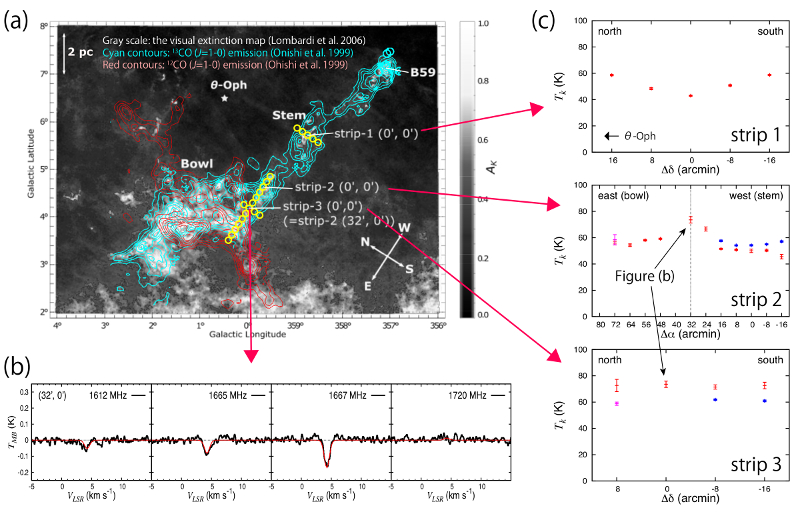
|
EPoS |
|
EPoS Contribution
|
|
Temperature Structure of the Pipe Nebula Studied by the Intensity Anomaly of the OH 18 cm
Yoko Oya U Tokyo, Tokyo, JP | |
| The 18 cm transition of the hydroxyl radical (OH) consists of four hyperfine structure lines at 1612, 1665, 1667, and 1729 MHz. It is well known that the observed intensity ratio of the four hyperfine structure lines is often different from the ratio expected in the local thermodynamic equilibrium condition. Such an intensity anomaly is caused by collisional and/or radiative processes among the rotational states. Their intensity ratio of the hyperfine structure lines is sensitive to the gas kinetic temperature, and we found that the intensity ratio can be used as an accurate thermometer of warm (> 30 K) molecular clouds. In this study, we apply this method to a nearby molecular cloud, the Pipe Nebula. The Pipe Nebula is a filamentaly massive molecular cloud complex, consisting of two filamentary structures (Figure a). It was suggested that these two structures are colliding with each other in the overlapping region based on their analyses combining the optical polarimetry, the visual extinction, and 13CO observation. We observed the Pipe Nebula in the four hyperfine structure lines of the OH 18 cm transition with Green Bank Telescope. A statistical equilibrium analysis is applied to the spectra (Figure b), and the kinetic temperature of a diffuse molecular gas surrrounding dense cores is determined accurately; the derived temperature ranges from 40 K to 75 K (Figure c). Along the strip 1, the gas kinetic temperature is found to be almost independent of the distance from θ-Ophiuchi, suggesting that the UV-heating effect by the star is not significant. On the other hand, the gas kinetic temperature is raised as high as ~75 K at the interface of the two filamentary structures (strip 3). This result provides us with an additional evidence of the filament-filament collision in the Pipe nebula. | |
 | |
| Caption: (a) The Pipe Nebula. Yellow circles represent the observed positions in the OH 18 cm transition. (b) Spectra of the four hyperfine structure lines of the OH 18 cm transition observed on the (+32', 0') position on the strip 2 (the cross section of the strips 2 and 3). Red lines show the Gaussian profiles with the best-fit parameters derived from statistical equilibrium calculations; the gas kinetic temperature is determined to be 73.6 ± 0.8 K. (c) The derived kinetic temperatures along the three strips. The blue, red, and magenta colors represent different velocity components; the blue and red marks correspond to the W-E and the S-N filament, respectively. Along the strip 1, the UV-heating effect by θ-Ophiuchi is not seen. In the strip 2, the kinetic temperature was found to be raised at the position (32', 0'), where the two filaments interface with each other. Strip 3 is taken as the interface of the two filaments, and the kinetic temperature was found to be as high as ⪆ 60 K, supporting the filament-filament collision scenario. | |
| Collaborators: Y. Ebisawa, SMBC, JP N. Sakai, RIKEN, JP K. M. Menten, MPIfR, DE S. Yamamoto, U Tokyo, JP |
Key publication
Suggested Session: Molecular Clouds |